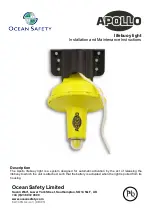
Page 816
CHAPTER 8
May/12
9107
SERVICE MANUAL
Page 816
Feb/11
CHAPTER 8
283
SERVICE MANUAL
ISO 9650
3.4 While the liferaft is deflating and the tubes have become soft, check the
function of each liferaft inflation valve. To do this use bursts of compressed
CO
2
air or nitrogen for 5 to 10 seconds to ensure proper function.
When blast testing check there are no leaks coming from the valves.
3.5 Fit the valve protection pad, (FIGURE 816), 1 for each inflation valve, two in
total. Secure them with a reef knot.
WARNING:
A FULLY CHARGED CYLINDER CAN BECOME A LETHAL
PROJECTILE IF DISCHARGED TO ATMOSPHERE WHEN NOT
FITTED WITH A RECOIL CAP. ALWAYS FIT A RECOIL CAP
TO A CYLINDER VALVE OUTLET WHEN HANDLING A FULLY
CHARGED CYLINDER.
CAUTION:
RELIABLE FUNCTIONING OF AN OPERATING HEAD
DEPENDS UPON SCRUPULOUSLY OBSERVED
RESETTING PROCEDURES. DO NOT TRY TO RESET
BY FORCING THE CABLE BACK INTO AN ASSEMBLED
HEAD.
3.5.1 Check and, if required, reset operating heads according to the
manufacturer’s documentation (refer to the Associated Publications
section).
3.5.2 Refer to the List of Associated Publications for the correct filling data
for gas cylinders and to the Illustrated Parts List for correct cylinder
application. Check the weight of the gas cylinder against the data
printed on the cylinder label. Reject a cylinder if the data on the label
is illegible. Disassemble, check, test, assemble and charge cylinders
according to the associated manual.
































